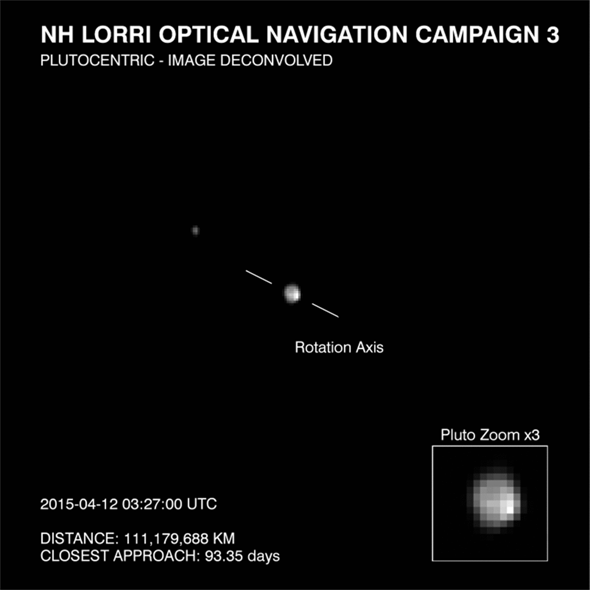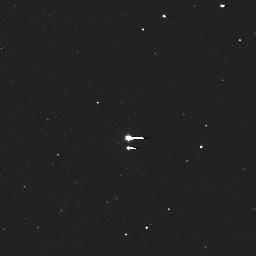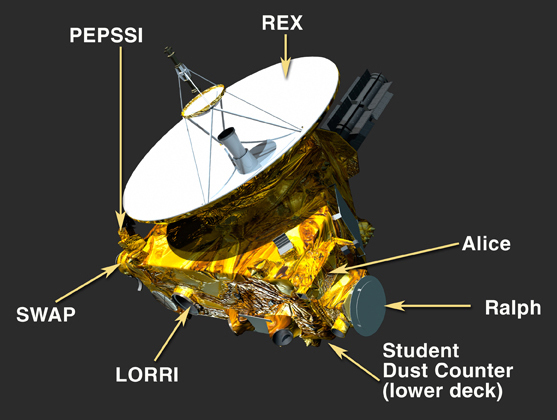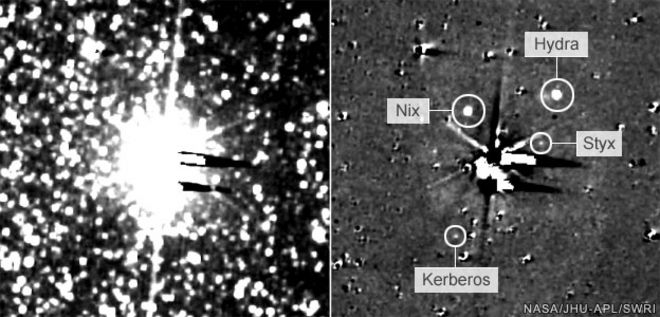General Discussion
Related: Editorials & Other Articles, Issue Forums, Alliance Forums, Region ForumsPluto on the viewscreen, Captain.
New Horizons Sees Features on Pluto!
by Phil Plait
Slate, April 29, 2015
At a press conference on Wednesday astronomers working on the New Horizons space probe revealed new images that show surface features on Pluto for the first time!
The probe was just over 100 million kilometers from Pluto when the images were taken on April 12–18 (the Earth is 150 million km from the Sun, for comparison). Hubble images taken over the years have shown the diminutive world has darker and lighter patches on its surface, and these images match that.
In fact, these images are now at higher resolution than Hubble can produce! And they'll be getting better every day ...
Pluto looks lumpy in the animation, but that’s certainly an illusion; darker spots near the edge make it look like Pluto has chunks taken out of it. It’s expected that Pluto will be quite round; its gravity should compress it enough for it to be mostly spherical. I wonder if it’ll be oblate (slightly flattened) due to tides from its moon Charon. We’ll know pretty soon.
Charon can be seen in the animation as well, orbiting Pluto once every six days or so. Actually, it’s about ¼ the diameter of Pluto, and massive enough that it pulls on its parent pretty hard, hard enough that it’s more correct to say they both orbit their common barycenter, their center of mass.
Great links, more:
http://www.slate.com/blogs/bad_astronomy/2015/04/29/pluto_new_horizons_sees_surface_features_for_the_first_time.html
Imaging promises to get better and better till the July fly-by, and that should be something too, as scientists can use the sun shining through the Plutonic atmosphere to get an idea of its composition.
hifiguy
(33,688 posts)Astronomy is fascinating!
Octafish
(55,745 posts)People of Earth:
Only rarely do you get the chance to explore a new world, so buckle up because the moment is approaching at a speed of 30,000 mph. That’s how fast NASA’s New Horizons spacecraft is hurtling toward its destination of tiny, distant Pluto. Just 60 million miles or so to go before the planned July 14 flyby – after a journey lasting more than nine years and 3 billion miles.
You remember Pluto, the once-beloved planet, smallest, maybe cutest of the nine with its oddball elliptical orbit, until it was kicked out of the band like a disrespected drummer. That happened in 2006 because it did not meet new criteria for planethood set by the International Astronomical Union. Pluto’s a dwarf planet now.
But let’s look past that insult to consider the science and meaning of NASA’s fantastic voyage. Pluto is the final major, unexplored destination in our solar system (well, that we know about). Scientists, and even curious grade-schoolers, know a lot about the other planets because NASA spacecraft have flown to each. They know less about Pluto, which has been viewed and studied only from afar.
The last breakthrough moment of this type was in 1989 when NASA’s Voyager 2 flew past Neptune, becoming the only object from earth to visit planet No. 8. That spacecraft discovered four rings around Neptune and five moons, one of which, Triton, has a nitrogen ice volcano.
Voyager 1 and Voyager 2 continue to fly. They are way out in deep space now, but neither cruised past Pluto. So while there have been plenty of other astronomical discoveries since that visit to Neptune, there’s been no new world to conquer – until now.
“You think of Pluto as a dot of light,” Alan Stern, New Horizons’ principal investigator, or top scientist, told us. “It’s about to become a real world in living color.”
SNIP...
On its $700 million journey, managed by Johns Hopkins’ Applied Physics Laboratory, New Horizons will map the geology of icy Pluto and study its atmosphere and seasons. It also will look at Charon and the other four known moons that orbit Pluto. After that? Whoosh! Assuming funding is approved to continue the mission, New Horizons will head deeper into the Kuiper Belt, the mysterious neighborhood surrounding Pluto that spreads toward the outer edges of our solar system.
There are billions of comets out there in the Kuiper Belt, maybe 100,000 larger bodies and something like six to 60 other Pluto-like proto-planets. That’s why Pluto was downgraded in the first place. It turned out to be the most visible of many little floating objects that never congealed into something bigger.
CONTINUED...
http://www.visaliatimesdelta.com/story/opinion/2015/04/27/nasas-new-horizons-voyage-pluto-cosmic/26316553/
PS: It IS cool, hifiguy!
2banon
(7,321 posts)Octafish
(55,745 posts)
BY EVAN DASHEVSKY
PC Mag, APRIL 30, 2015
All spacecraft must die, but not all spacecraft really live. And for the past four years, NASA's Messenger spacecraft lived as few spacecraft have: making history as the very first spacecraft to orbit Mercury, the closest planet to the sun.
Ever since entering Mercury's orbit on March 18, 2011, Messenger has given project scientists (and by extension, humanity) an unprecedented up-close view of the tiny, rocky planet. Over the course of its mission, the spacecraft has been the source of several startling discoveries, including that of a tenuous (and season-prone!) atmosphere, past volcanic activity, and even small collections of water ice hidden in the shadows of craters in the polar region. That last discovery is particularly nuts considering that daytime temperatures at the Mercurian equator can top 800 degrees.
[font color="blue"]But that will all come to an end today when—at precisely 3:26 p.m. ET—Mercury's surface will receive one more crater when Messenger crashes into the planet's surface due to a dwindling supply of propellant and the effects of solar gravity.[/font color] (If you were wondering, scientists are predicting that the ensuing man-made crater will be 52 feet in diameter).
Unfortunately—from a voyeuristic vantage point—the Earth will not get a clear shot of the impact. But space p0rn aficionados, do not despair! Over the past month, the probe has dutifully added to its library of more than 270,000 images with some beautiful close-ups of the planet's surface.
SOURCE: http://www.pcmag.com/slideshow/story/334105/11-amazing-images-from-the-final-days-of-nasa-s-messenger-pr
PS: You are most welcome, 2banon! Space exploration IS fascinating.
that is quite interesting.
Octafish
(55,745 posts)My prediction, my theory, which is mine, is as follows: A theory on Pluto from G_j's friend on DU: New Horizons will confirm the presence of organic molecules in Pluto's atmosphere and surface -- not that there is life, but that the outer solar system contains the basic organic chemistry necessary for life.

Paining by Frank R. Paul. More artists conceptions of life on Pluto here.
The surface of Pluto is extremely cold, roughly 40 degrees above absolute zero (minus 387° Fahrenheit or minus 233° Celsius), so it seems unlikely that life could exist there. At such cold temperatures, water, which is vital for life as we know it, is essentially rock-like. Pluto's interior is warmer, however, and some think there could even be an ocean deep inside.
Life as we know it requires three things:
• Water
• Biogenic elements such as carbon, phosphorus and sulfur, in addition to the oxygen and hydrogen in water
• A source of energy (light, heat, chemical potential) that a living organism can use
Pluto's surface is far too cold for liquid water, but its interior is probably warm and maintained that way by the slow decay of naturally occurring elements such as uranium, potassium-40 and thorium.
Enough heat is released that a water ocean may exist between the rocky core of Pluto and its thick outer layer of ice. Planetary scientists have long thought that icy satellites might possess oceanic layers underneath their surface ice layers. The discovery by the Galileo orbiter that Europa, Callisto and possibly Ganymede possess interior oceans greatly increases our expectation that Pluto also possesses an ocean. Pluto's ocean is also likely to contain biogenic elements in a solution, especially if it is in contact with an organic-rich layer.
Where Pluto probably does not pass astrobiological muster is in the matter of sufficient energy to power life. Pluto's ocean would be dark and cold - near-freezing. Even if in contact with a rock core, it is almost certainly true that this modest core is today insufficiently hot to be volcanically active or even to drive circulations. So it is difficult to argue for a deep biosphere on Pluto today. On the other hand, it is also true that Pluto's rock core was much hotter and probably active in the geological past, so it is not utter lunacy to speculate that some form of primitive, microbial life may have evolved long ago and just might have once plied the "Styxian seas" of Pluto.
http://pluto.jhuapl.edu/Mission/FAQs.php
It IS quite interesting, G_j!
AuntPatsy
(9,904 posts)Octafish
(55,745 posts)
Michael Summers
New Horizons Co-Investigator, February 24, 2015,
How big is Pluto’s atmosphere? This is not a typical question one finds in planetary science. Earth’s atmosphere has an equivalent thickness – the thickness if you compress the atmosphere to uniform pressure and density – of about 10 kilometers, or six miles. Compare this with the radius of Earth, 6,370 kilometers, and you see that the razor-thin thickness of Earth’s atmosphere is about 0.17% of its radius. Even if you consider the “outer limit” of Earth’s neutral atmosphere, what we call the exobase, that reaches about 600 kilometers altitude, the atmosphere’s equivalent thickness is only 10% of Earth’s radius—still very thin. So the volume of Earth’s atmosphere is tiny compared to Earth’s volume.
But now consider Pluto. Its atmosphere has a near-surface equivalent thickness of about 40 kilometers, which is almost 4% of its 1,200- kilometer (or so) radius. But the “outer limit” of Pluto’s atmosphere is very difficult to define, although we know that it is very far from the surface. If one defines it similar to the way we define the exobase of Earth’s atmosphere, then Pluto’s atmosphere has an outer limit of at least seven times Pluto’s radius above it surface. This means that the volume of Pluto’s atmosphere is over 350 times the volume of Pluto itself! This illustrates what a strange and wonderful new kind of world we are about to visit and explore.
And this estimate is conservative. As I noted, the outer limit for Pluto’s atmosphere is ill-defined because of the gradual way that the atmosphere merges with the vacuum of space. It could in fact be farther than seven Pluto radii from its surface, and thus its volume would be even larger.
Size will be one of the central questions we answer about Pluto’s atmosphere with New Horizons during the Pluto system encounter in July. The answer will have implications for many aspects of the atmosphere’s characteristics, such as the thermal structure, solar ionization, solar wind interactions, escape rate, and even its interaction with Pluto’s large moon, Charon. I can’t wait!
Michael E. Summers is a professor of Planetary Science and Astronomy at George Mason University, and specializes in the study of the chemistry and dynamics of planetary atmospheres. He is a New Horizons co-investigator and member of the atmospheres science theme team.
SOURCE: http://pluto.jhuapl.edu/News-Center/Science-Shorts.php?page=ScienceShorts_02_24_2015
PS: It IS incredible, AuntPatsy!
AuntPatsy
(9,904 posts)arcane1
(38,613 posts)Octafish
(55,745 posts)New images from the New Horizons probe approaching Pluto indicate it might have a polar cap of nitrogen ice, NASA says.
The observation came in a series of pixilated images taken April 12-19 as the spacecraft closed in from 69 million miles to 64 million miles. Combined into an animation, the latest views show a rotating Pluto circled by Charon, the largest of its five known moons.
How cold is it on Pluto? Its surface temperature is estimated at minus 387 degrees Fahrenheit.
The images also reveal "changing brightness patterns from place to place as Pluto rotates, presumably caused by large-scale dark and bright patches," NASA said Tuesday.
Another series of images is planned from May 8-14, and NASA is promising another movie in mid-May. Daily observations will begin May 28 with "better and better resolution."
CONTINUED...
http://www.usatoday.com/story/tech/2015/04/29/pluto-new-horizons-images-polar-cap/26594269/
PS: It IS great, arcane1!
ScreamingMeemie
(68,918 posts)Octafish
(55,745 posts)NASA, Johns Hopkins Applied Physics Lab, and the Southwestern Research Institute make a fine use of tax dollars: Knowledge of what was Hidden to every human being to live before our time.

http://pluto.jhuapl.edu/soc/Pluto-Encounter/
It IS absolutely fascinating, ScreamingMeemie!
sharp_stick
(14,400 posts)just so far away and the fact that we can send a probe out there is amazing.
Truly thrilling science.
Octafish
(55,745 posts)
A major challenge for the New Horizons mission is the relatively low "downlink" rate at which data can be transmitted to Earth, especially when you compare it to rates now common for high-speed Internet surfers.
During the Jupiter flyby in February 2007, New Horizons sent data home at about 38 kilobits per second (kbps), which is slightly slower than the transmission speed for most computer modems. The average downlink rate after New Horizons passes Pluto (and sends the bulk of its encounter data back to Earth) is approximately 2,000 bits per second, a rate the spacecraft achieves by downlinking with both of its transmitters through NASA's largest antennas. Even then, it will take until late 2016 to bring down all the encounter data stored on the spacecraft's recorders.
Since NASA's Deep Space Network has to track other missions besides New Horizons, the team plans to produce a lossy compressed browse data set that can be sent down more quickly. The browse dataset will be downlinked before the end of 2015; the complete dataset will be downlinked after the browse dataset.
SOURCE: http://pluto.jhuapl.edu/Mission/Spacecraft/Data-Collection.php
T-Husky from somewhere on the Internet adds...
Radio waves travel at the speed of light, so therefore it will take 4hrs 33min 10sec for a radio transmission to travel from Pluto to Earth at this time.
At this distance, New Horizons' bandwidth (or rate of transmission) is limited to 1Kbit/s, so the total time it will take for the transmission to complete will depend on the size of the data packet being transmitted.
The size of the data packet cannot be precisely estimated, however a useful baseline might be taken from New Horizons' 2007 flyby of Jupiter, which generated a 36Gbit data set... so if the Pluto flyby generates a similar sized data set, it would take 447days 9hrs 24mins of uninterrupted transmission for the full data set to be received on Earth (plus 4hrs 33mins travel time).
However, that would only be true if New Horizons maintained the same distance from Earth for the entire duration of the data transmission; New Horizons will actually continue to travel further away from the Earth / Sun, so the time for a complete transmission will take significantly longer, both as the signal strength is further weakened, and the time required for the data packets to travel increases with distance.
http://www.reddit.com/r/space/comments/2qi9ti/when_new_horizons_arrives_at_pluto_how_much_time/
PS: It IS truly thrilling science, sharp_stick!
Liberal_Dog
(11,075 posts)Octafish
(55,745 posts)The most common question I've been asked about this image today is: Is Pluto lumpy? The answer is no; Pluto is round. It appears lumpy because of those very brightness variations that the scientists are so excited about. Wherever a bright spot is near the edge of the disk, it looks like an upward lump; wherever a dark spot is near the edge, it looks like a downward lump. The variations in surface brightness are probably going to make it very hard to figure out what kind of topography Pluto actually has until we're quite close to it. In the meantime, they make animations of Pluto very interesting!
The other big announcement today is that the New Horizons team has begun sharing their raw images on the Web! Unlike with the Jupiter flyby, where they shared lossless PNG-formatted data, they are putting the Pluto images out in lossy JPEG format, which reduces their quality. While of course I'd love to have PNGs, lossy JPEG format is a tradeoff I'm certainly willing to accept in exchange for rapid access to images that help me to follow the mission! They say that images will generally appear on the raw images website within 48 hours of their receipt.
http://www.planetary.org/blogs/emily-lakdawalla/2015/04291753-new-horizons-sees-surface.html
PS: Thanks for grokking, Liberal_Dog! President Kennedy wanted the exploration of outer space to replace "Westerward Expansion." Brilliant idea, as the planet is getting crowded and the only solution to world problems most of today's leaders can see is war.
Blue_Tires
(55,445 posts)Octafish
(55,745 posts)The Real Spiders from Mars...

These "spiders" on Mars' surface are caused by carbon dioxide coming from dry ice during summer on the polar regions. (Credit: NASA)
Pluto could have geysers
Buratti and colleagues from Boston University, UCLA and Grays Harbor College report their findings on Pluto in the Astrophysical Journal Letters. They predict that New Horizons will find explosive geysers similar to those previously found on Triton and Mars, in light of the similarity between the dwarf planet and Neptune’s largest moon.
“We are pretty close to polar summer – so there is a lot of frost there to sublimate,” she pointed out, referring to the process where solid ice skips the liquid phase and turns directly into gas. As the sun’s rays hits the surface, they should be powerful enough to penetrate frozen nitrogen, even though Pluto is 32 times farther away from the sun than the Earth.
That would allow the dwarf planets polar cap to trap enough energy to convert some of that ice into pockets of gas, which accumulates pressure until it breaks through the surface. The impact of that blast would send nitrogen ice crystals all over the place, forming the spider-like patterns. Data from New Horizons should be able to prove or disprove this hypothesis.
SOURCE: http://www.redorbit.com/news/space/1113378771/new-horizons-to-study-spider-like-patterns-on-pluto-042715/
PS: Amazing times, ours, Blue_Tires! Thanks for grokking!
Blue_Tires
(55,445 posts)The irony is when I was a kid I was expecting space travel/exploration to be much farther ahead than we are now...
yuiyoshida
(41,831 posts)
Spitfire of ATJ
(32,723 posts)
Fleas.
Octafish
(55,745 posts)
Figure 2: Ranger 8 Estimated Impact Point (Crater C1). Image credit: LOIRP.
"The Lunar Orbiter II-070-H image (Frame 70, High resolution) has a unique feature that is relevant to the LCROSS mission. This image shows the impact site of the Ranger 8 mission. This location was identified decades ago and is discussed in the NASA SP-168. This location was also photographed during the Apollo 16 mission (NASA SP-315 page 29-46) but at a lower resolution of 3-5 meters. The image was taken from an altitude of 45.81 km. The resolution is about 0.4 meters per pixel. The crater from the Ranger impact is not well defined in the existing film database, especially as it appears at the boundary between two framelets."
SOURCE: http://nasawatch.com/archives/2009/06/new-image-of-ranger-8-impact-site.html
neverforget
(9,436 posts)I can't wait to see and learn more!
Octafish
(55,745 posts)
NASA's hardest working probe has finally run out of fuel, and the MESSENGER will meet a tragic fate as it crashes into the planet Mercury on April 30. See the amazing photos this probe shared with us in its very extended lifespan.
MESSENGER (an acronym of MErcury Surface, Space ENvironment, GEochemistry, and Ranging) launched into space in August 2004 on a mission to study Mercury. After four years of traveling across 4.9 billion miles, MESSENGER finally flew by Mercury in January 2008. However, it would take two more years and two more flybys before the probe could slow itself down enough to enter into Mercury's orbit in March 2011.
But MESSENGER proved to be a role model for NASA probes, successfully completing its yearlong mission to study the chemical composition, geology and magnetic field of the smallest planet in our solar system. It proved to do so well, its mission was extended twice.
Perhaps the greatest achievement of MESSENGER was the discovery of large amounts of ice water on Mercury's poles. This was highly unexpected by scientists since the planet is so close to the Sun, with surface temperatures reaching a vaporizing 800 degrees Fahrenheit in daylight. However, because Mercury has such a small axis tilt, the craters near the poles have never have been exposed to the sunlight, and its water still survives.
President Obama awarded MESSENGER's Principal Investigator Sean Solomon with the National Medal of Science, the nation's top scientific honor, on Nov. 20, 2014.
NASA hopes to crash MESSENGER into Mercury a few hours early so it can receive photos throughout the probe's final moments before it impacts on the surface. When it does, the 1,000-pound probe will create a crater 52 feet in diameter.
SOURCE: http://abc7.com/weather/photos-amazing-photos-of-mercury-from-ill-fated-nasa-probe/687962/
PS: Me, too, neverforget! I can't wait to see and learn more. Remember Cervantes:
“El que lee mucho y anda mucho, ve mucho y sabe mucho.”
Octafish
(55,745 posts)At left is the unprocessed Lorri image. Once processed, at right, the faint moons can be seen

Probe spies Pluto's faint moons
By Jonathan Amos
BBC Science Correspondent, May 13, 2015
The New Horizons probe, heading for its historic flyby of Pluto in July, has now caught sight of all the known faint moons of the dwarf planet.
They have been revealed in new images downlinked from the Nasa spacecraft, which is still some 90 million km from reaching the distant world.
Hydra and Nix were seen previously, but New Horizons can also now resolve Kerberos and Styx.
Pluto's fifth known moon, Charon, is much larger and brighter.
By comparison, it is relatively easy to detect, although in the new image-set just released it is burnt out with Pluto at the centre of the frame.
Pluto has a diameter of about 2,300km; Charon is half that. Hydra may reach over 100km.
CONTINUED...
http://www.bbc.com/news/science-environment-32724092
Octafish
(55,745 posts)